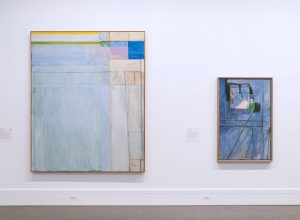Art News: Striking Up a Conversation: The Baltimore Museum of Art Unites Matisse and Diebenkorn in a Glorious Exhibition
January 19, 2017
By Phyllis Tuchman

Though many critics and curators rate Richard Diebenkorn highly, the public still seems less familiar with his art than they should be. Expect this to change with “Matisse/Diebenkorn,” currently at the Baltimore Museum of Art and traveling to SFMOMA in March. It’s a glorious show featuring almost 60 well-selected paintings and works on paper by the Californian alongside three dozen or so canvases, including many beloved masterpieces, as well as drawings by the great French modernist.
The latest themed exhibition du jour at museums and galleries across the United States and Europe calls attention to two artists who share similar aesthetics. This seems to be the art world’s equivalent of the Hollywood buddy movie. Typically, the show is either the story of two friends and colleagues, or an old-timer admired by someone younger, or artists from different countries and/or cultures sharing much in common. In the past few months, there have been two-person shows devoted to Alberto Giacometti and Pablo Picasso, Alexander Calder and Picasso, Diego Rivera and Picasso, Edvard Munch and Jasper Johns, Giacometti and Yves Klein, Giacometti and Bruce Nauman, Willem de Kooning and John Chamberlain, Jean Dubuffet and Larry Poons, and even de Kooning and Zao Wou-Ki. As it is, I’m probably missing a few.
Not all these exhibitions work, but showcasing the art of Matisse and Diebenkorn makes great sense. Diebenkorn had a lifelong—and well-documented—interest in the French Modernist’s paintings. Diebenkorn saw his first Matisses in person when, as a Stanford University undergraduate, he visited the Palo Alto home of collector Sarah Stein. By 1943, Stein owned more than 100 paintings, drawings, prints, sculptures, and ceramics by Matisse, including his haunting 1916 portrait of her, and the enchanting Woman with a Hat (1905).

About a year later, as a newly married Marine stationed just outside Washington, D.C., during World War II, the young soldier frequented the nearby Phillips Collection and traveled to the Museum of Modern Art in New York and the Philadelphia Museum of Art. At each institution, he continued to be enthralled by Matisse’s color combinations, sinuous lines, and flair for composition—and he was intrigued, too, by the former Fauve’s pentimenti, decorative flourishes, and downright awkwardness.
Recalling the retrospective with 66 works by Matisse that he saw in Los Angeles in 1952 while visiting his in-laws, Diebenkorn said, “It absolutely turned my head around.” He would get up close and personal with Matisse at least two more times. During a cultural exchange trip he made to the USSR in 1963, he made pilgrimages to both the Pushkin Museum in Moscow and the Hermitage in Leningrad where he saw Matisses that never traveled outside Russia. And, in 1966, he was impressed by yet another body of pictures he saw in a much-praised retrospective at the UCLA Art Gallery.